
How to deal with dog separation anxiety

Dr Jessica May, FirstVet vet
2 December 2021 | 10 minutes read
It’s wonderful how our canines show us unconditional love, but what happens when that need for constant attention from and closeness to you goes too far?
With many people working from home during the pandemic, some of us may be guilty of having spent too much time with our loyal canines. Have you reached the point where, even if it’s just for a few minutes, they’re distressed if you leave them?
Although it may sometimes feel like you’re alone in your behavioural struggles, dog separation anxiety is a shared problem for many owners. There’s a range of reasons why a dog might become anxious, along with different ways to prevent and deal with it, so jump in with FirstVet Dr Jessica May to find out more.
Table of Contents
- What is dog separation anxiety?
- What causes dog separation anxiety?
- What are the symptoms of dog anxiety?
- How to prevent dog separation anxiety
- How to break a dog’s separation anxiety
- Separation anxiety in older dogs
- Puppy separation anxiety
- Get advice from your vet
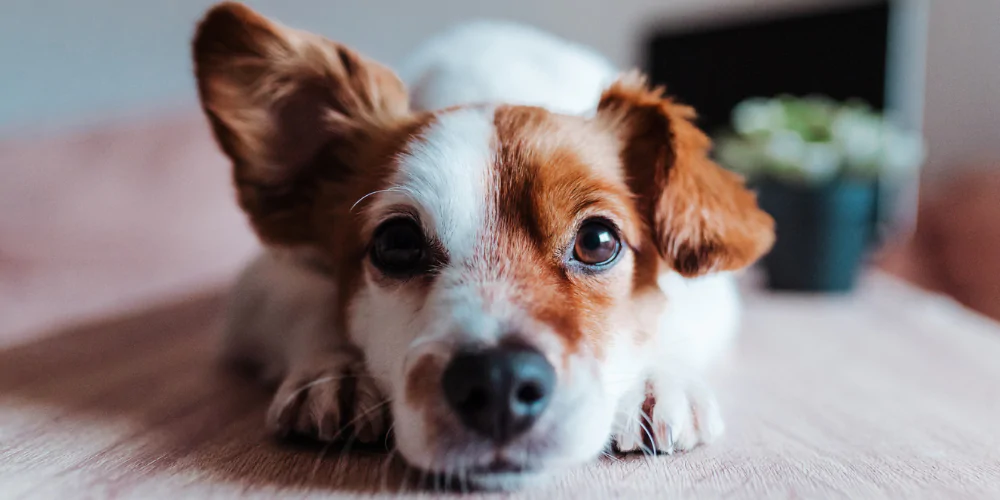
What is dog separation anxiety?
Dog separation anxiety is a behaviour where your pup becomes distressed when they have to be apart from you. This can display itself in a number of ways, and often within just a few minutes of you leaving.
As we mentioned, it’s more common than you may think, and canines of all ages (including puppies and older dogs) can show separation-related behaviour. Some signs of separation anxiety are more clear, while others may not be as obvious.
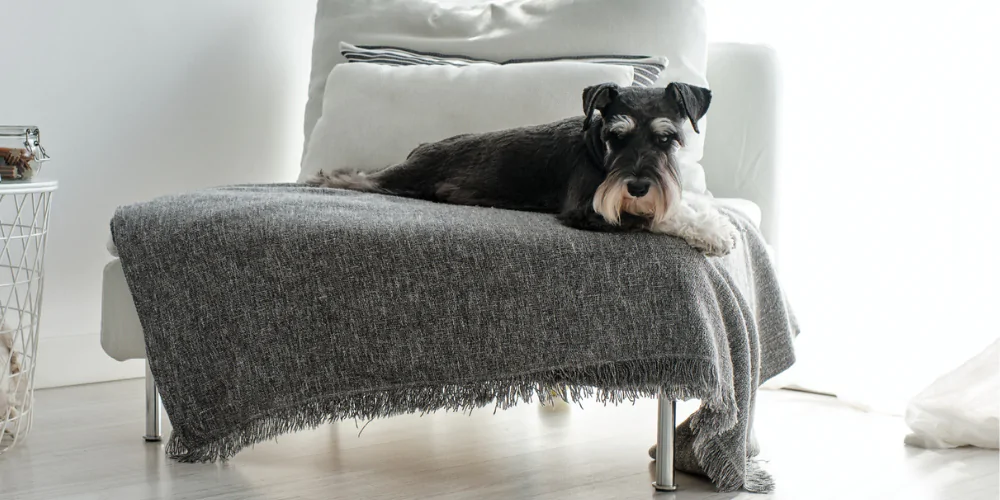
What causes dog separation anxiety?
So, what exactly causes dog separation anxiety? Well, it ultimately may come down to one or a combination of the following reasons:
- Losing a family member or another animal companion.
- Moving house or to a completely different area, creating a new and unfamiliar environment.
- Getting constant attention from their humans with no focus on encouraging independent play.
- Consistently being left alone for extended periods of time (such as for more than four consecutive hours).
- Not going through a slow and gradual training plan for being left alone.
- Not getting enough stimulation and enrichment, resulting in boredom, stress, and frustration.
- A sudden and abrupt change in routine or schedule.
- A history of trauma from a previous home or living as a stray (if fostered or adopted).
- Being a breed which may be genetically prone to developing separation anxiety.
> Dog breeds with separation anxiety
Some dog breeds may be more likely to develop separation anxiety than others. These breeds are highly sociable canines with a strong pack mentality, meaning they could become highly attached to their owner. Of course, it often comes down to your dog’s individual personality, so each pooch is unique.
- Bichon Frise
- Hungarian Vizsla
- German Shepherd
- Labrador Retriever
- Jack Russell Terrier
- Border Collie
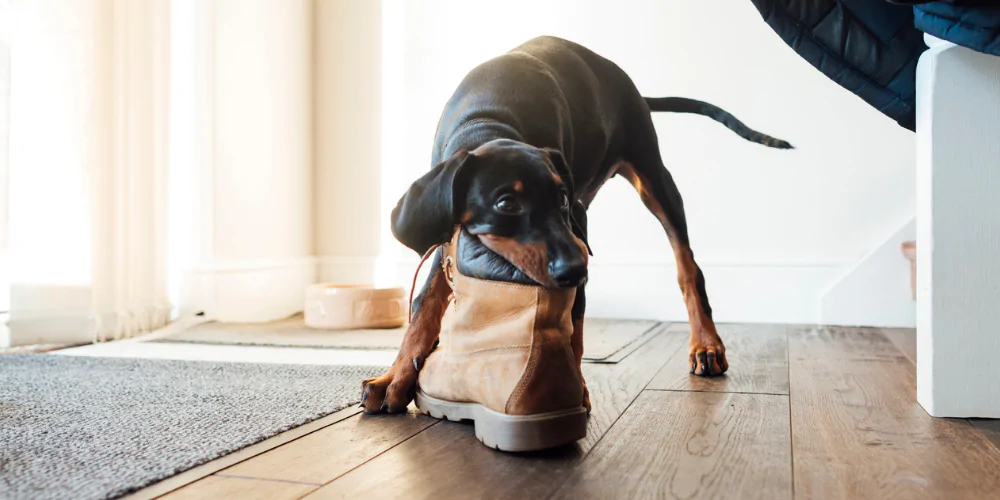
What are the symptoms of dog anxiety?
It’s possible to tell if your dog is stressed or anxious from numerous different signs. You may find that your dog displays some of these behaviours more during the night, but most often it’s when you’ve just left the house, which is why it may help to set up a pet camera to catch these indicators.
- Excessive whining, barking, or howling.
- Urinating and defecating inside the house.
- Chewing furniture, doors, and skirting boards, or chewing items with your scent on them.
- Frantically scratching at doors and carpets.
- Jumping up at doors and window sills to look for you.
- Constantly following you around the house.
- Excessive panting and salivating, particularly just as you leave or when you first return home.
- Pacing around when they can see you are about to leave.
- Working themselves up so much that they vomit.
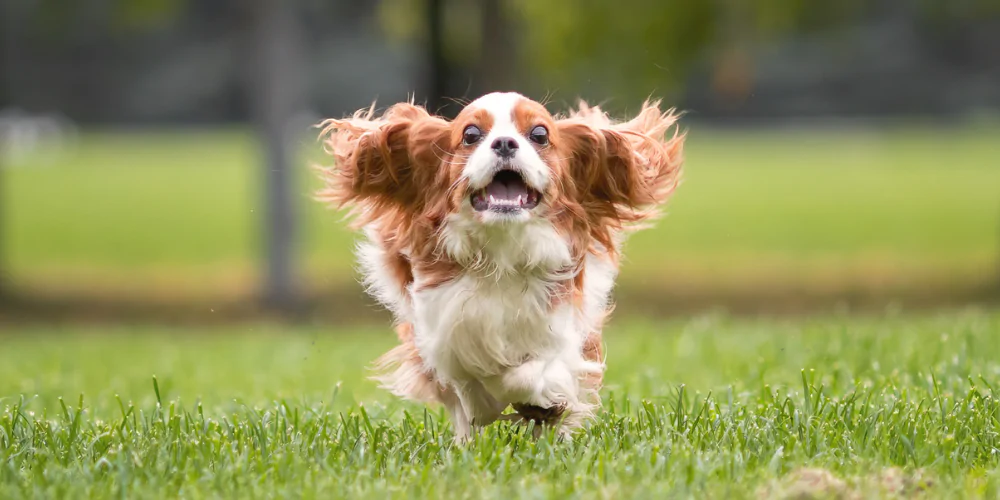
How to prevent dog separation anxiety
Preparation is often key to success and, in this case, preventing dog separation anxiety. Some of the things you can do to help avoid your pup getting anxious include:
- Introduce plenty of socialisation when they’re puppies (and have had their puppy vaccinations, of course). Arrange puppy play dates or hire out a dog walking field if you want a controlled area for them to socialise outdoors.
- Establish a routine as soon as possible so they know what to expect when it comes to feeding, play time, and bedtime.
- Gradually increase the time you spend away from them. Begin with a few seconds and build this up to a few minutes in another room, giving them positive reinforcement if they’re calm and settled. Using a stair gate may help at this stage as your dog can still see, smell, and hear you, while maintaining that separation.
- When they’re ready, start leaving them alone in the house for 30 minute periods until you’ve increased this to several hours. Do this regularly so they get used to being alone.
- Returning to the house should be a calm process. Don’t fuss your pooch and speak to them in a relaxed, neutral tone. This may help to avoid your dog associating your return as something to be worked up over.
- Desensitise your dog to ‘leaving cues’, which may include sounds such as the jangle of keys or the rustle of a coat. Regularly make these noises throughout the day without actually leaving the house, so they don’t panic and associate them with you leaving.
- Create a comfortable and safe place where they know they can go if they need some peace and calm.
- Install a dog flap or make a plan for allowing your dog to get out into the garden when they need to go to the toilet.
- Give them plenty of stimulating toys for their enrichment. We’re talking things like destruction boxes, chew toys, and puzzle games, particularly if there’s a high food reward involved.
- Rotate these to avoid boredom and ensure they’re safe to be left with your pup when they’re alone.
- Dedicate specific one-on-one playtime with your dog. At other times, encourage independent play with a toy, so they’re not always looking to you for entertainment.
- Take your canine companion on regular walks and mix up the route or area for variety. Keep in mind that dogs may need several long walks a day to burn up their energy.
- Switch on a radio or create a dog-friendly playlist for when you leave. Some dogs find background noise more soothing than a completely quiet house.
- Aim to have each member of the household spend an equal amount of time with your dog, so they aren’t fixated on being with one person all the time.
- Speak to your vet about introducing supplements or calming plug-ins that may help to keep your dog relaxed.
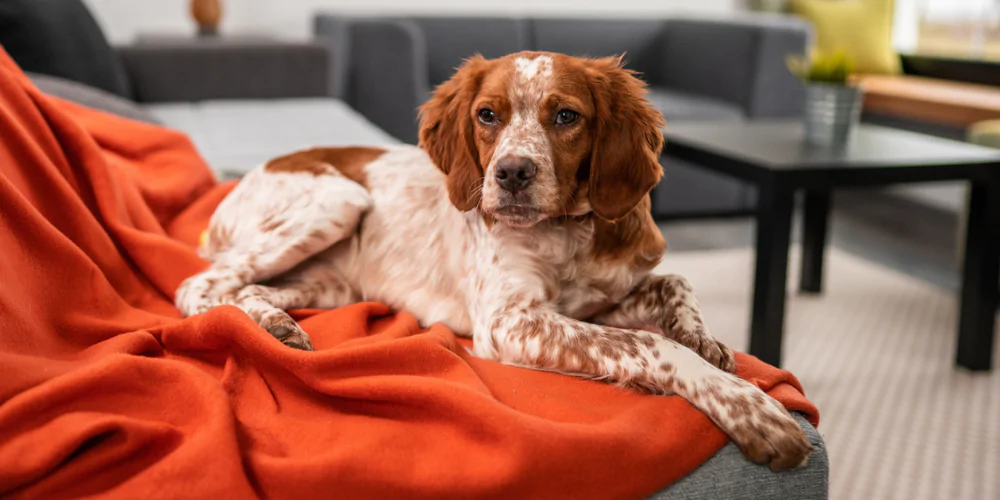
How to break a dog’s separation anxiety
You may be at the stage where your dog is already showing signs of separation anxiety. Your Petsure dog policy includes 24/7 access to FirstVet, so it’s a good first point of call for advice. You can also reach out to your vet who can check for any medical causes as well as give recommendations for a specialist or behaviourist, if needed. While you wait for an appointment, there’s a few things you can do that may help to temporarily break your dog’s separation anxiety.
> How to calm an already anxious dog
- Bring them into a calm and quiet space with the curtains drawn. The idea is to limit the amount of potentially triggering sensory stimulations such as cars, people, and other dogs passing by.
- Give them a toy they don’t have access to very often, so they’re fully engaged with play.
- Give them a stuffed toy filled with their favourite frozen treat to hopefully occupy them for a good while.
- Leave a soft piece of clothing that you’ve already worn with them to act as a comforter. Only do this if you’re confident they won’t chew it.
- Keep up with any prescribed medication from your vet, giving the correct dosage at the recommended times each day.
- Bring someone trusted (and who your dog knows and feels comfortable with) to watch them when you go out.
- If no one trusted is available to come over and your dog has more severe anxiety, if you can, try and take them to work with you until you can speak to a specialist.
> How to stop a dog barking when home alone
Keeping your dog occupied may help to stop them barking when home alone. Give them plenty of mentally-engaging toys and rotate these weekly so they don’t get fed up. More challenging puzzles may keep them occupied for longer, especially if they reward your dog with a treat.
Put them in a room towards the back of the house where they’re less likely to hear distracting outside noises. Leave the TV or radio on or even use a white noise machine so they’re not left in silence.
> How to stop a dog from tearing things up when left alone
One way to help stop your dog from tearing things up when left alone is to give them dedicated items to destroy. Fill up a cardboard box with scrunched up newspaper and empty toilet rolls, then scatter treats underneath. Your dog can snuffle around for the treats and then chew the recycled items when they’re done scavenging.
You could also give them long-lasting natural chews like deer antlers, as long as this fits in with their diet and there’s no risk of choking. Put away any other items that you don’t want them to chew (like shoes). Build up a positive association with the things they’re allowed to gnaw on, such as their toys.
Taking them out for a good walk before you leave may also help draw out any excess energy that could lead to destructive chewing.
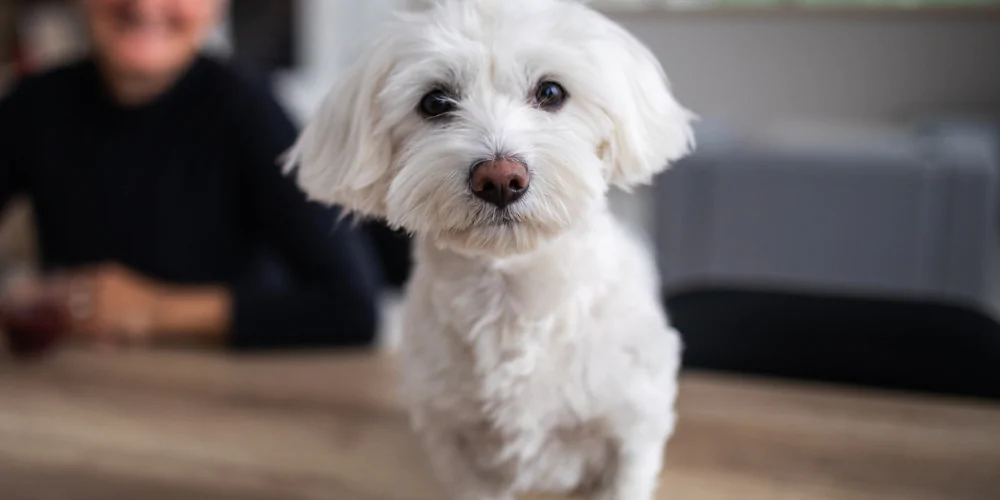
Separation anxiety in older dogs
As your dog gets older, they may develop anxiety they never used to have as a younger pup. A combination of things may lead to them becoming anxious, such as:
- Increased sensitivity to new and unfamiliar sights, sounds, and smells.
- Loss of sight or hearing.
- Increased nervousness around new people or dogs.
You’ll normally be able to tell that it’s separation anxiety specifically if the behaviours we mentioned earlier appear when you leave the house. They may also manifest during the night, as your older dog sees going to bed as another distressing time where they have to be apart from you.
Older dogs are more prone to developing chronic conditions, which is why it’s important to consult a vet in case these signs of anxiety are a result of an illness or disease.
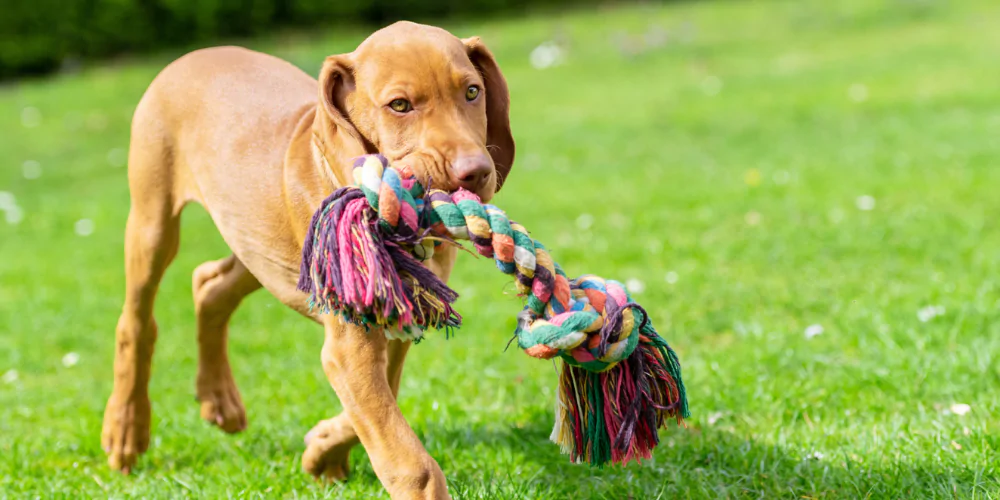
Puppy separation anxiety
Puppies can develop separation anxiety just as much as older dogs. Training a dog to be left alone is often easier to do when they’re younger and haven’t already settled into behaviours and habits. Introduce as many of the steps for preventing separation anxiety as soon as possible after welcoming your new pup into the family.
> Do puppies grow out of separation anxiety?
Separation anxiety is not simply an age problem, which is why your puppy won’t just grow out of their anxiety and it doesn’t disappear by itself over time. When you start to see signs of separation anxiety in your puppy, take action by booking an appointment with your vet.
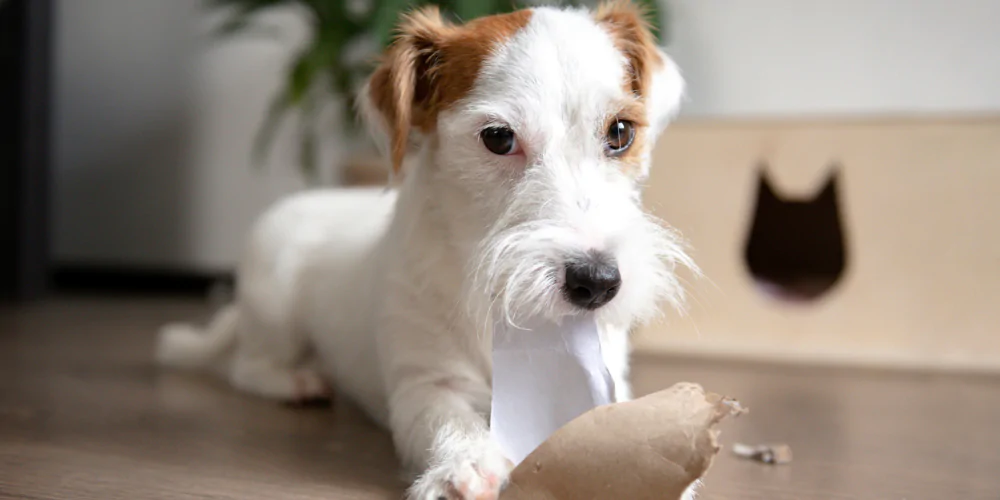
Get advice from your vet
Getting professional help is often the safest course of action when it comes to dog separation anxiety. When your canine companion is acting out of sorts or their behaviour is worrying you, reach out to a vet.
FirstVet offers 24/7 video appointments with a UK-based vet, so you always have help available should your dog show signs of stress or anxiety. FirstVet can give you immediate advice, as well as recommend an in-person appointment, should your dog need to be examined for a potential medical issue.
Taking care of your dog is of the utmost importance, from their physical to their mental wellbeing. Protect your pup with lifetime dog insurance.


